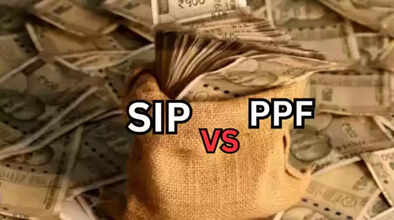Journey from Rs 10,000 per month to Rs 1 crore: SIP, PPF or Gold, which will make you a millionaire faster?

Everyone always wants their money to grow fast, and a big fund can be created in the future. So if you are investing Rs 10,000 every month and your target is to create a fund of Rs 1 crore, then you have great options like SIP (Systematic Investment Plan), PPF (Public Provident Fund), and Gold. But the question is, which of these investments will take you to Rs 1 crore the fastest? So then compare these three options in simple language and understand which one can be better for you.
What is SIP, and how does it work?
Let us tell you that SIP is an easy way to invest in mutual funds. In this, you invest a fixed amount every month, like Rs 10,000, in a mutual fund. Actually, this money is invested in the stock market, whose returns depend on the market conditions. So if you assume a 15% annual return in a good equity fund, then by investing Rs 10,000 every month, in 20 years, your invested fund can be Rs 24 lakh, and the maturity fund can be Rs 1.3 crore. But the risk in SIP is higher, but the return can also be higher in the long run.
PPF: Safe and tax-free returns
PPF is a government-backed savings scheme in which your money is completely safe. Currently, PPF offers an interest rate of 7.1%, which increases every year. In this, you can deposit a maximum of Rs 1.5 lakh (i.e., Rs 12,500 per month) every year. But by investing Rs 10,000 per month (ie, Rs 1.2 lakh annually), with 7.1% interest, your fund can become Rs 76 lakh in 25 years and Rs 1.19 crore in 30 years. Money is locked in PPF for 15 years, but it can be extended for 5 5 years, it is also tax-free and risk-free.
Gold: Protection from inflation
Investing in gold, such as a gold ETF, a sovereign gold bond, or physical gold, has long been a favorite of Indians. Gold prices rise over time, and they protect against inflation. In the last 15-20 years, gold has given an average annual return of 9%. If you invest Rs 10,000 every month in gold, then with 9% return, your fund can become around Rs 83 lakh in 22 years and around Rs 1 crore in 25 years, although the risk in gold is less than SIP but more than PPF.
Comparison: Which will make 1 crore the fastest?
SIP:
If you get a 15% return, then you will have a fund of 1.3 crore rupees in 20 years, but there is a risk of market fluctuations.
PPF:
With 7.1% interest, you will have 1.19 crore rupees in 30 years. It is completely safe, but it takes more time.
Gold:
With 9% return, you will make 1.14 crore rupees in 25 years, but it is less risky than SIP, but not as safe as PPF.
That is, it is clear that SIP can achieve the target of 1 crore rupees the fastest, but there is more risk in it. Although PPF is the safest, it takes more time; gold is the middle path between these two.
So then, who to choose?
Which investment is right for you depends on your needs and risk-taking ability. So if you can take a risk and invest for 20 years, then SIP is the best. Also, if you want a safe investment without risk, then choose PPF. Also, if you want protection from inflation and a moderate risk, then gold is good.
Understand some precautions
SIP:
Understand the market risk and choose a good fund and invest in it for a long time.
PPF:
The money remains locked for 15 years, and you choose this for a long period.
Gold:
Instead of physical gold, choose a Gold ETF or Sovereign Gold Bond, so that there is no worry about storage and security.
So now it is clear that it is possible to create a fund of Rs 1 crore by investing Rs 10,000 every month. SIP can achieve this goal in 20 years, but with risk. While PPF gives tax-free and safe returns in 30 years, gold achieves the goal in 25 years with moderate risk. (Note: This article is for information only and should not be considered as investment advice in any way. recommend consulting financial advisors for investment)
Disclaimer: This content has been sourced and edited from Zee Business. While we have made modifications for clarity and presentation, the original content belongs to its respective authors and website. We do not claim ownership of the content.

